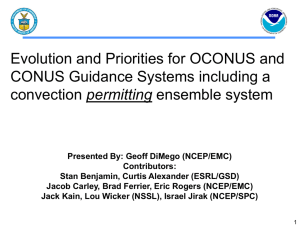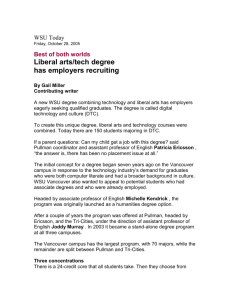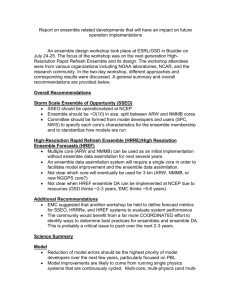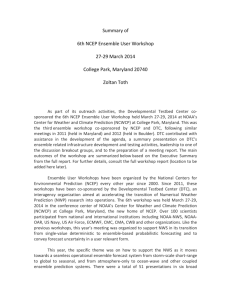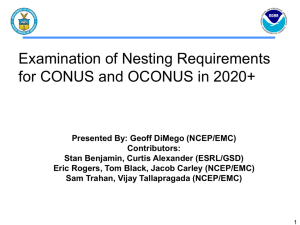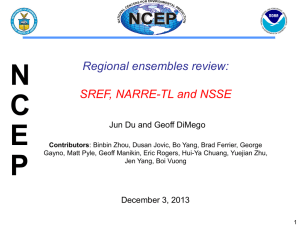Task Title
advertisement
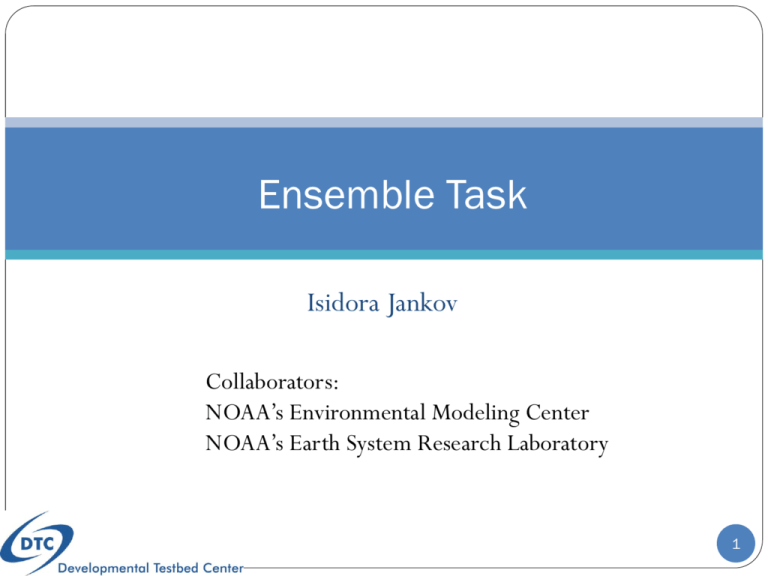
Ensemble Task Isidora Jankov Collaborators: NOAA’s Environmental Modeling Center NOAA’s Earth System Research Laboratory 1 Ensemble Task AOP12 Activities Activity HWRF ensemble for GSI-Hybrid Applications methods Establish a functionally similar environment of the NCEP SREF Status Moved to the DA task Accomplished HMT Winter Experiment Delayed Evaluate ensemble products using CAPS, AFWA, and NCEP algorithms On hold Ensemble Code Repository Accomplished Co-host semi-annual DTC Ensemble Task Workshop Accomplished Maintain ensemble group wiki page and web site On-going Work done late in AOP11, DTC contribution to SREF post-processing 2 Work performed late in AOP11 NAEFS Bias Correction and Downscaling effort High-resolution version of SREF (SREFx) was recently implemented operationally at EMC. SREFx at 16km (NMM, NMMB)/17km (ARW) resolution Significant resolution upgrade, but still missing small scale variability needed for NWS forecast grids Downscaling to the resolution of the NDFD (~5km) should allow greater use of NCEP SREF output in the production of forecasts Courtesy of Brian Etherton, Jun Du and Tara Jensen 3 Bias Correction and Downscaling FORECASTS NMM NMMB ANALYSES BC NAM ARW RTMA DS Approach used in NAEFS Bias Correction accomplished by taking the mean forecast of each model core (ARW, NMM, etc.) sub-ensemble of the NCEP SREF and comparing it to the NAM analysis valid at the same time. Downscale by comparing the RTMA analysis (GRID 259, like GRID 197, 1073x689, 5.079km) with the NAM analysis valid at the same time (10m wind,2m temperature and humidity). Courtesy of Brian Etherton, Jun Du and Tara Jensen 4 Bias Correction and Downscaling FORECASTS NMM NMMB ANALYSES BC NAM ARW RTMA DS Recursive averaging method is used (~30 day mean) Bias-Correction (in operations) and Downscaling (DTC testing) from NAEFS Bias corrected and downscaled fields for each member Also: downscaled forecasts of ensemble min, max, mean, spread, 10th, 50th, and 90th percentiles. Courtesy of Brian Etherton, Jun Du and Tara Jensen 5 Implementation of downscaling at EMC Downscaling code used for NAEFS ported to DTC Testing/evaluation of code application to existing NCEP SREF output showed forecast improvement DTC code sent to EMC (Jun Du) for application to the new 16km/17km NCEP SREF Code implemented by EMC in approximately 2 days, with downscaled forecasts being produced since December (Presentation at AMS Annual Meeting ) Courtesy of Brian Etherton, Jun Du and Tara Jensen 6 Implementation of bias correction at EMC 3 2.5 2 1.5 SREFX_raw 1 SREFX_BC 0.5 0 3 0.4 0.35 0.3 0.25 0.2 0.15 0.1 0.05 0 -0.05 SREFX_raw SREFX_BC no skill 3 15 27 39 51 63 75 87 15 27 39 51 63 75 87 Ens mean fcst of T2m: RMSE Prob fcst of T2m: RPSS (12km NAM as ref) Raw SREFx vs Bias corrected SREFx (Nov. 10 – 30, 2011, against NDAS) Courtesy of Jun Du, NOAA/EMC 7 Testing/Evaluation at DTC - Results As implemented at DTC, the bias correction reduces the RMSE of 2m T forecasts & the downscaling adds further improvement. Courtesy of Brian Etherton, Jun Du and Tara Jensen ARW and NMM members of SREF 2011 – 0900 UTC Initialization 8 Compared to RTMA Analyses Ensemble Task AOP12 Activities Activity HWRF ensemble for GSI-Hybrid Applications methods Establish a functionally similar environment of the NCEP SREF Status Moved to the DA task Accomplished HMT Winter Experiment Delayed Evaluate ensemble products using CAPS, AFWA, and NCEP algorithms On hold Ensemble Code Repository Accomplished Co-host semi-annual DTC Ensemble Task Workshop Accomplished Maintain ensemble group wiki page and web site On-going 9 NCEP SREF Functionally Similar Environment Activity description: Define & establish scalable, flexible , highly portable heterogeneous computational Functionally Similar Environment, (FSE) to NCEP SREF operations. Objectives and Accomplishments: 1.Develop FSE acceptance evaluation criteria in collaboration w/ NCEP 2.Establish portable integration of NCEP SREF components & DTC platforms 3.Participate in updates of NCEP NEMS code, SREF scripts & data cross management 4.Continually support research, DET T&E workflow & future R2O integrations 5.Analyze the differences & integrate NCEP operative & DET research workflows 6.Work closely w/ EMC to deploy computational & research innovations. Courtesy of Eugene Mirvis 10 Major Accomplishment: • NCEP SREF v6.0.0 adapted by DTC • DTC now has functionally similar environment for 4-5 of 6 SREF modules 11 New Generation of The Ensemble Testbed 1. DEVELOPMENT OF THE FSE ACCEPTANCE CRITERIA OPS ENVIRON -MENT 3. PARTICIPATE IN UPDATES, OPS CODE & DATA MANAGEMENT Conventions & Criteria Of Functional Similarity 6. ACADEMIA SUPPORT & INNOVATIONS DTC/DE T TESTBED ENVIRON -MENT 5. MERGING OPS AND RESEARCH WORKFLOWS NOAA ESRL ~ 60 UNIVERSITIES 2. PORTABLE INTEGRATION of OPS & Research Computing Platforms 4. SUPPORT RESEARCH, T&E WORKFLOW 12 12 NCEP NEMS – DTC Ensemble Workflows Merging Analysis External data processing Ensemble Initialization NEMS Stochastic Forcing Perturbation Component Alternative Obs. data NEMS entry RIP4 NEMS Apps Layer BIAS Correct & downscale GSI NPS Standard •Obs. data Terrestrial DATA IC/LBC perturb Land surface perturb YES GLOB ? MESO Gridded Data: NAM,GFS, RUC, snow, ice, SST U P P Cold start NEMS/WRF Land surface init NO ? - - not used yet at NCEP Ensemble Post Post Visualize & Verify Shared Physics NEMS I/O GrADS GEMPAK NCL Ensemble post and product generation MET Grid-vs-Grid VSDB/FVS Grid-vs-Obs VSDB/FVS 13 Ensemble Task AOP12 Activities Activity HWRF ensemble for GSI-Hybrid Applications methods Establish a functionally similar environment of the NCEP SREF Status Moved to the DA task Accomplished HMT Winter Experiment Delayed Evaluate ensemble products using CAPS, AFWA, and NCEP algorithms On hold Ensemble Code Repository Accomplished Co-host semi-annual DTC Ensemble Task Workshop Accomplished Maintain ensemble group wiki page and web site On-going 14 HMT Winter Experiment Activity description: Use HMTWinter Experiment real-time system to test the impacts of alternate initial perturbation techniques (including the dynamical downscaling of global perturbations) Test alternate ensemble perturbation techniques (cloud microphysical parameterizations Presentation at NWA Annual. Accomplishments: Plans developed NWA presentation delivered Issues: This task has been affected by changes in staffing which resulted in a significant delay. 15 HMT Activities AOP12 HMT real time DTC 1 DTC 2 Microphysics HMT SREF (ARW) HMT Initial Perturbations HMT HMT SREF (ARW) Grid Spacing 9 9 9 1 2 1. Evaluate the impact of changes in microphysics 2. Evaluate the impact of initial perturbation changes 2012 Tasks necessary to be completed for 2013 activities. 16 Impact of Microphysics on 2010-2011 HMT NMM 90% Intensity show over forecast of precip for ARWFer and ARW-MY members especially at higher thresholds – which means when it rains it pours in these members Color groups Different Microphysics Ferrier Milbrant-Yau Thompson Difference (Fcst-Obs) in Near Peak Intensity in MODE Obj (mm) Using Attributes from MODE Objects ARW HMT NAM GFS Optimal Object Threshold (mm) > 25.4 Intense Cores Courtesy of Tara Jensen 17 Initial Perturbations Approach Legend Perturbation Global Model Analysis interpolated on LAM grid Global Model Forecast LAM Forecast 00Z 06Z Forecast Time XaL = XfL + (XaG – XfG) 18 Proposed Activities for 2013 19 Ensembles AOP 2013 Proposed Activities ID HMT EN3 EN4 Activity Four tests related to implementation of the HMT innovations into SREF Evaluate options for optimal combination of reference dynamic cores and corresponding analyses in SREF (currently beyond 100%) Evaluate the merits of using 2 vs. 3 dynamic cores in SREF – using ARW subset available from HMT activity (currently beyond 100%) 20 Ensemble Proposed AOP 2013 Activities HMT CONTEXT SREF CONTEXT HMT Real time DTC 1 (AOP12) DTC 2 (AOP12) DTC 3 (AOP13) NCEP Operations Microphysics HMT SREF (ARW) HMT SREF (ARW) SREF Initial Perturbations HMT HMT SREF (ARW) SREF (ARW) SREF Grid Spacing 9 9 9 9 16 1 2&4 3 1. Evaluate impact of changes in initial conditions in context of SREF 2. Evaluate impact of HMT microphysics in context of SREF 3. Evaluate impact of increased resolution (16 vs. 9 km SREF) 4. Evaluate the impact of mixed microphysics by optimally combining 21 HMT and SREF runs. Verification Tressa L. Fowler 22 Verification AOP 2012 Activities AOP 2012 Activity Status MET releases in July and January Done / Slightly Delayed Enhancement of software testing Done, more in progress New verification tools for T&E support Some done, more in progress METViewer GUI enhancements Initial release of MET TC LSM verification In progress Slated for 4.1 release Delayed Tutorial Community presentations Feb 4-5 Many completed MET help ongoing 23 Goals Promote easy, consistent, correct verification across the NWP community, especially in operations where there is the greatest potential for impact. Create a cohesive team of scientists and software engineers engaged in challenging, interesting, rewarding work. 24 Accomplishments Software Development MET TC MADIS data support Ensemble spread skill GRIB2 Series analysis tool Testing and Evaluation support HMT verification MMET cases Community support 25 Series Analysis Tool Frequency Bias Gilbert Skill Score Happy Users 26 Verification Support of HMT HMT Ensemble Mean Capability was added to METViewer: User can constrain aggregation using Base Rate (aka, observed relative frequency). This feature helps users focus on model skill for meaningful events without having to constrain on an event-by-event basis No constraint Base Rate > 0.02 Increases analysis speed and relevance 27 Verification Implementations Confidence Tests Box-and-whiskers now on most FVS plots (thanks to Keith Brill of HPC) Slide excerpted from Geoff DiMego EMC Verification Website (intranet only): 28 http://emc-ls-sand02.ncep.noaa.gov/EMC_VSDB_verif/index.cgi Verification AOP 2013 Activities ID VX2 VX1 VX3 VX4 VX5 Activity Description Verification support for T&E activities Community Support: Release, tutorial, help MET Development – External users MET Development – Internal users MET-TC Development (currently beyond 100%) 29 Next Year Software Development – Internal Enhancements to MET TC in support of HWRF testing Series analysis tool testing and enhancements METViewer GUI redesign Software Development – External Satellite data and cloud verification Complete MODE GUI Land Surface Model evaluation capability Testing and Evaluation support HMT Evaluation Use of MET TC for HWRF evaluations Additional MMET cases Radiation scheme evaluation 30 Community Support Yearly tutorial, with HWRF tutorial if funded Updated online tutorial MET Help Verification lectures at conferences and workshops 31 MET TC Development Hurricane T&E development Community TC development 32 MODE GUI Capability developed outside DTC but will be leveraged for inclusion in community software! 33 Track Error Rank of Candidate Model vs. 3 Operational Models 34 Leveraging SURFRAD Development of SURFRAD ingest underway Useful for radiation scheme evaluations Land surface model verification Solar forecast evaluation for DOE project 35 Conclusions Some work will carry over to 2013, due to staffing changes. 2013 will be a year of rebuilding. We accomplished much in 2012. Our 2013 planned work reaches into new areas More opportunities to assist with R2O More learning opportunities for our staff 36 Director’s Office & Visitor Program Louisa Nance 37 Director’s Office AOP 2013 Activities AOP 2012 AOP 2013 Director’s Office Staff Director’s Office Staff Non-salary expenses: travel, external meetings, etc… Non-salary expenses: travel, external meetings, etc… (reduced budget by 20 K) Director’s Reserve (65 K) Director’s Reserve (65 K) – 85-100% DTC Visitor Program DTC Visitor Program – 85-100% External communications (status: newsletter is in progress) External communications – below 100% CO1: Investigate requirements ECMWFlike environment) – 85-100% CO2: Post-doctoral Scientist Program – 85-100% 38 Director’s Office Staff AOP 2012 AOP 2013 National Director (Kuo) 0.5FTE Assistant Director (Nance) 0.55 National Director (Kuo) 0.5FTE Assistant Director (Nance) 0.55 FTE JNT Management (Brown) 0.1 FTE Budget support (Jensen) 0.25 FTE Support staff for community activities (Johnson) 0.5 FTE GSD Management (Toth) 0.1 FTE Budget support (Etherton/Bernardet & Admin Asst) 0.25 FTE FTE JNT Management (Brown) 0.1 FTE Budget support (Jensen) 0.25 FTE Support staff for community activities (Zarlingo) 0.3 FTE GSD Management (Toth) 0.3 FTE Budget support (Etherton/Bernardet & Admin Asst) 0.30 FTE 39 External Meetings AOP 2012 3 Workshops 3 Tutorials 4 Governance meetings AOP 2013 1 Workshop 1 Tutorial 4 Governance meetings 40 DTC Visitor Program Framework for engaging the research community in projects directed at improving NWP, with an eye towards eventually improving operational forecasts 41 DTC Visitor Program Supports visitors to work w/ the DTC to test new forecasting & verification techniques, models & model components for NWP PI project – up to 2 months salary & travel & per diem Graduate student project - up to 1 yr temp living per diem stipend & travel expenses for student to work w/ DTC &/or one of its partners + travel & per diem for up to 2 2-wk visits to the location of the student by project PI 42 Current DTC Visitors PI Institution Project Title NCAR Development of an HWRF Diagnostics Module to Evaluate Intensity & Structure Using Synthetic Flight Paths Through Tropical Cyclones Adam Clark U. of Oklahoma Development & Application of 3-Dimensional Object Algorithms to High Resolution Forecasts Delia Arnold & Don Morton Technical U. of Catalonia / U. of Alaska –Fairbanks Moving The NEMS & NMM-B Into a Broader Community Resource Environment Robert Fovell / Travis Wilson UCLA Improvements to modeling persistent surface cold pools in WRF Sai Ravela MIT Deploying the MIT Field Alignment System & Test-bed (FAST) in DTC Jonathan Vigh 43 Future DTC Visitors PI Institution Thomas Galarneau NCAR Diagnosing Tropical Cyclone Motion Forecast Errors in HWRF Robert Fovell / Huang UCLA Improving HWRF Track and Intensity Forecasts Via Model Physics Evaluation and Tuning Man Zhang CSU Project Title Impact Assessment of Cloud-Affected AMSU-A Radiance Assimilation in TC inner-Core Region using Hybrid Data Assimilation Approaches Marion Mittermaier UKMET Incorporating Observations Uncertainty to a Spatial Probabilistic Verification Framework for km-scale Models Adam Clark U. of Oklahoma Object-based Time-Domain Diagnostics for Highresolution Ensemble Forecasting and Evaluation in NOAA/HWT Spring Forecasting Experiments 44 AOP 2012 Visitor Funds EC chair expressed concern over allocating all of the AOP 2012 funds budgeted for visitor program due to AOP 2013 funding uncertainties NSF funds cannot be reprogrammed to cover other DTC activities, so DTC moved forward with awarding 5 new visitor projects Estimate new projects will require only ~15-20 K from the NOAA AOP 2012 funding For continued NSF support, will be important to show NOAA matching, so plan to pursue off-cycle visitor proposals consistent with DTC priorities once we have a better picture of the AOP 2013 funding Demonstrating NOAA matching for visitor program will be important for future proposals to NSF for both the visitor program and potential Post-doctoral Scientist Program 45 Potential new activities Following new activities currently fall in the 85-100 % scenario 46 ECMWF-like Visitor Tools ($128K) Background: ECMWF has an interactive meteorological software application that allows researchers to easily prepare & execute research experiments. Scope: Investigate current capabilities & consider options for building & expanding capabilities to easily prepare & run research experiments using NCEP’s models. Requirements analysis: Identify user community (skills, needs) Identify system components adaptable to these needs Identify hardware, software & data needs & resources Identify documentation & training needs Preliminary system design Planning requires EMC staff participation in this info gathering stage! 47 Post-doctoral Scientist Program ($151K) Motivation: Mechanism for engaging next generation scientists in research focused on improving operational forecasts Proposed format: • Gather information from EMC on key areas for which they are interested in contributions from the research community • Applicants submit proposals for projects focused on an identified key area • Successful applicant would reside at EMC in order to work closely with EMC staff and gain better understanding of operational requirements 48 Summary • Activities that engage the NWP community and keep the community informed about DTC activities are important to fullfilling the DTC mission • Need to make sure we don’t overlook the importance of these activities and determine which types are most effective 49

